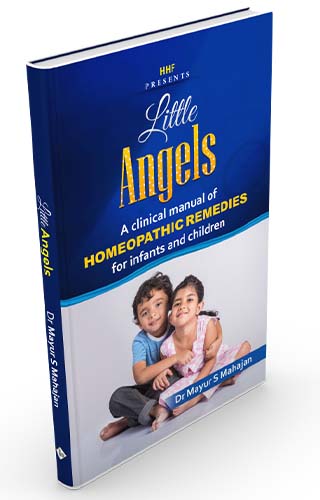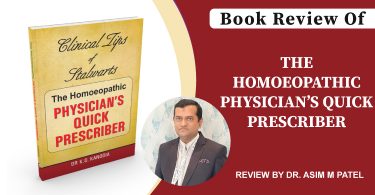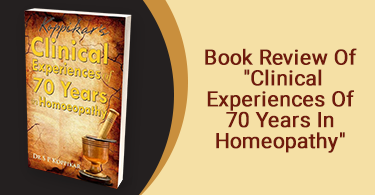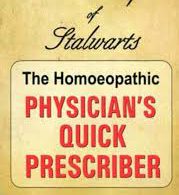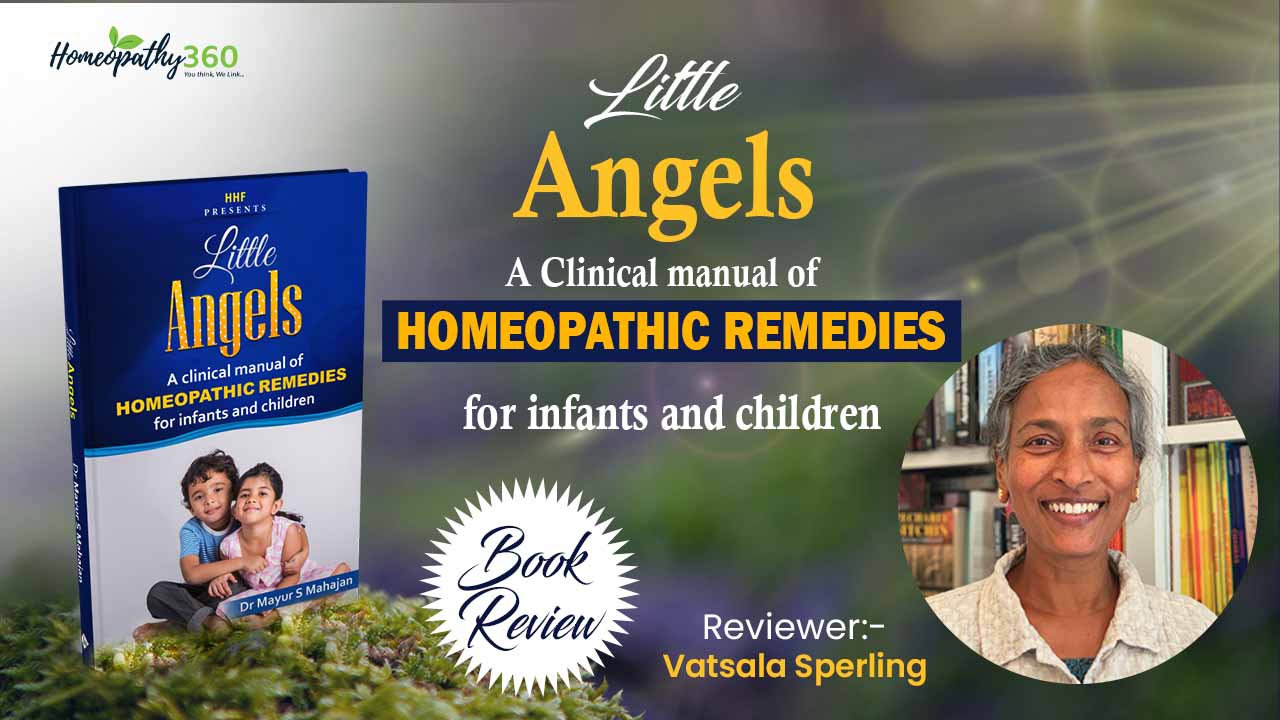
Recently, while attending a webinar series conducted by Dr. Gaurang Gaikwad, I heard Dr. Mayur Mahajan’s presentation. He had a uniquely funny, and yet deeply compassionate and humane approach to children’s cases.
In the West, particularly in the USA, homeopaths mostly work as general-purpose family practitioners and shy away from calling themselves specialists in any specific discipline (there are a few exceptions). Dr. Mahajan’s presentation confirmed for me that of course, homeopaths can choose a discipline they resonate with the most, put their heart and soul into becoming the best in their chosen area, and be a ‘specialist’.
From this angle, this book, “Little Angels, A Clinical Manual Of Homeopathic Remedies For Infants And Children” written by Dr. Mayur Mahajan is bound to be interesting for homeopaths with a specialization in pediatrics.
On reading this book, I find that it has a broader range of appeal as well. It can also be very handy and useful for family members and relatives who study homeopathy as a hobby and provide immediate care for family members, kids included, at home, using remedies from their collection that has grown over the years.
Particularly in the USA, since the widespread and much publicized repression of homeopathy by health authorities, homeopathy has survived to this day because young mothers carry homeopathy on their shoulders and care for their kids at home using remedies available in the health food stores. These moms (in my heart, I salute them silently and with deep admiration) will find a fantastic use for this book.
Dr. Milind Rao, in his foreword, says that this book will change your outlook toward homeopathic perception in children. Now, this line pushes my curiosity button. If a book can change my perception, I will drop everything else and read it.
Dr. Ashok Mohan has commented, “I am amused at how Dr. Mayur handles those lovable toddlers in his clinic. His narration of cases with gestures and mimicry brings the patients alive in front of us.” I could only agree with this comment. During his presentation, Dr. Mayur creates pictures with words…pictures of children, their illnesses, their remedies, their behavior that call out for a remedy… and these vibrant pictures are hard to forget.
From such a vivacious, lively, and well-experienced teacher, I expect a book no less than the very best. Now I must read the book and find out if he does indeed bring remedies and patients alive on the pages of this book so that both homeopaths and lay readers with interest in homeopathy can relate to these vibrant images.
In children’s cases, our observations are very important and along with the history and account of illness given by the primary caregivers, our observations of the child can guide us toward a fuller understanding. Dr. Aniruddha Joshi corroborates that the author is a keen observer.
Does he use his power of observation and share it with the readers of this book, encouraging them to develop a similarly keen sense of observation? We can find this out by reading this book.
Dr. Mahajan begins the book by sharing his early experiences of “difficulties” in practice. He read a lot but found it “difficult” to apply his knowledge clinically on real patients. He ended up failing more than succeeding. But he was determined to not give up.
It is said that the key to success is trying one more time after every failure. Dr Mahajan persisted, did not turn his back on the problem, and he took each failure as an opportunity to learn more, learn deeper and learn better from teachers who had mastered the art and the science of homeopathy. His apprenticeship with these seasoned stalwarts inspired him to make homeopathy “SIMPLE” and this book, in my view, is an outcome of that inspiration.
I like “simple”. Our materia medicas are great at giving us remedy pictures in a head-to toe format and these pictures, as collections of symptoms, sound very clinical. Our ancient and classical materia medicas generally do not mention socio-psychological nuances that color the environment in which children grow.
Judith Ullman mentions Saccharum for children adopted from orphanages where they were very likely denied love and warmth in their infancy and early childhood. Jan Scholten calls Magnesia carbonica the remedy of choice for orphans. But this book, Little Angels, begins with an introductory chapter on socio-psychological environment and how we ought to sharpen our wits and understand these aspects of children’s lives, if we want to serve these children in the true sense of the word.
In this chapter, with surgical precision, Dr. Mahajan has addressed topics like nuclear family, joint family, long gap between siblings, pampered kids, domineering parents and so on. He also encourages us to make keen observations regarding tone, gestures, dirtiness / cleanliness levels, dress / clothing, sensitiveness, or carefree personality, and use these signposts for forming our first impression – because, as you rightly guessed, mostly children do not speak for themselves. We need to observe with all our five senses.
Next, Dr. Mahajan focuses on
Carried – desires to be carried – constantly
Hard to inferiors – kind to superiors
Sensitive children
Timid and shy babies
Playful children
Destructive and hyperactive children
Fearful babies
Fear of examination
Nursing – desire to nurse all the time
In a practice focused on children, these aspects mentioned above could be the specific observations by the practitioner, or these could be the way the primary caregiver describes the child. Either way, we can learn from Dr. Mahajan’s experience of these aspects as he has laid them out in this book, as distinct chapters.
In each of the above-mentioned chapters, we get to read about a few of the most highly indicated remedies and by the time we get to the end of the book, we would gather a gift of crystal clear images and indications of 35 different remedies – all commonly available, and in use for the past couple of centuries!
Take for example, “carried, desire to be carried, constantly.” In this chapter, Dr. Mahajan mentions Cina, Chamomilla, Arsenicum album, Antimonium tartaricum, Kali carbonicum, and Sanicula. For each of these remedies, he goes into a case from his practice, rubrics taken, most useful rubrics to be considered, and finally, how to understand a Cina child, an Arsenicum album child, and so on.
These descriptions are unlike what you would usually get to read in our old or new materia medicas. A picture of the remedies – as expressed in children – is the core, the strength, and the beauty of this book. If Dr. Mahajan keeps writing volume after volume, focusing on remedy images as seen in children, he would make an unparalleled and totally unique contribution to pediatric homeopathy.
After you read Cina and Chamomilla in this book, and how they are expressed in children, you will never ever be confused about which of these remedies to give to a child who wants to be carried constantly.
In his lucid, simple, easy to grasp style Dr. Mahajan has described his experience and observation of Cina, Chamomilla, Arsenicum album, Antimonium tartaricum, Kali carbonicum, Sanicula, Lycopodium, Lachesis, Veratrum album, Platina, Ignatia, Carcinocin, Pulsatilla, Staphysagria, Silicea, Baryta carbonica, Ambra grisea, Cocculus, Tuberculinum, Tarentutal hispanica, Stramonium, Hyoscyamus, Gelsemium, Argentum nitricum, Calcarea phosphorica, Kali phosphorica, Nux vomica, Phosphorus, Hammamelis, Moschus, Spongia, Pertussin, Borax, Sulphur, and Calcarea carbonica. For each of these remedies he has given a brief and picturesque case, analysis and evaluation, and very adeptly, he has chiseled out a sharp and clear image / essence of the remedy – as seen in children.
I found this book to be light-hearted, entertaining, to the point, and reader friendly. It is engaging for professional homeopaths as well as lay readers. After reading it, irrespective of whether you are a homeopath or simply a consumer of homeopathy, a lay reader – you will gain some clarity, some confidence, and some “can-do-spirit” that is so essential to your success as a practitioner or a free-lance home prescriber, and I strongly recommend this book to both.
Vatsala Sperling, RSHom (NA), CCH, MS, PhD, PD Hom was the Chief of Clinical Microbiology services at a children’s hospital in Chennai, India, when she published extensively and conducted research with WHO, Denmark. On moving to the USA to start a family, Vatsala pursued an education in Homeopathy with Misha Norland’s school. She is a published author of ten books including her latest, The Ayurvedic Reset Diet (www.InnerTraditions.com). Journals from US and abroad frequently publish articles and papers written by Vatsala Sperling on topics including spirituality, health and homeopathy. Vatsala continues to study with several teachers and practices classical homeopathy. She has served on the board of directors of NASH and currently she serves as a volunteer with NCH. She can be reached via her website (www.Rochesterhomeopathy.com)

Title: Little Angels A Clinical Manual Of Homeopathic Remedies For Infants And Children
Author Name: Dr Mayur S Mahajan
ISBN: 9788131918043
Format: Paperback
Language: English


